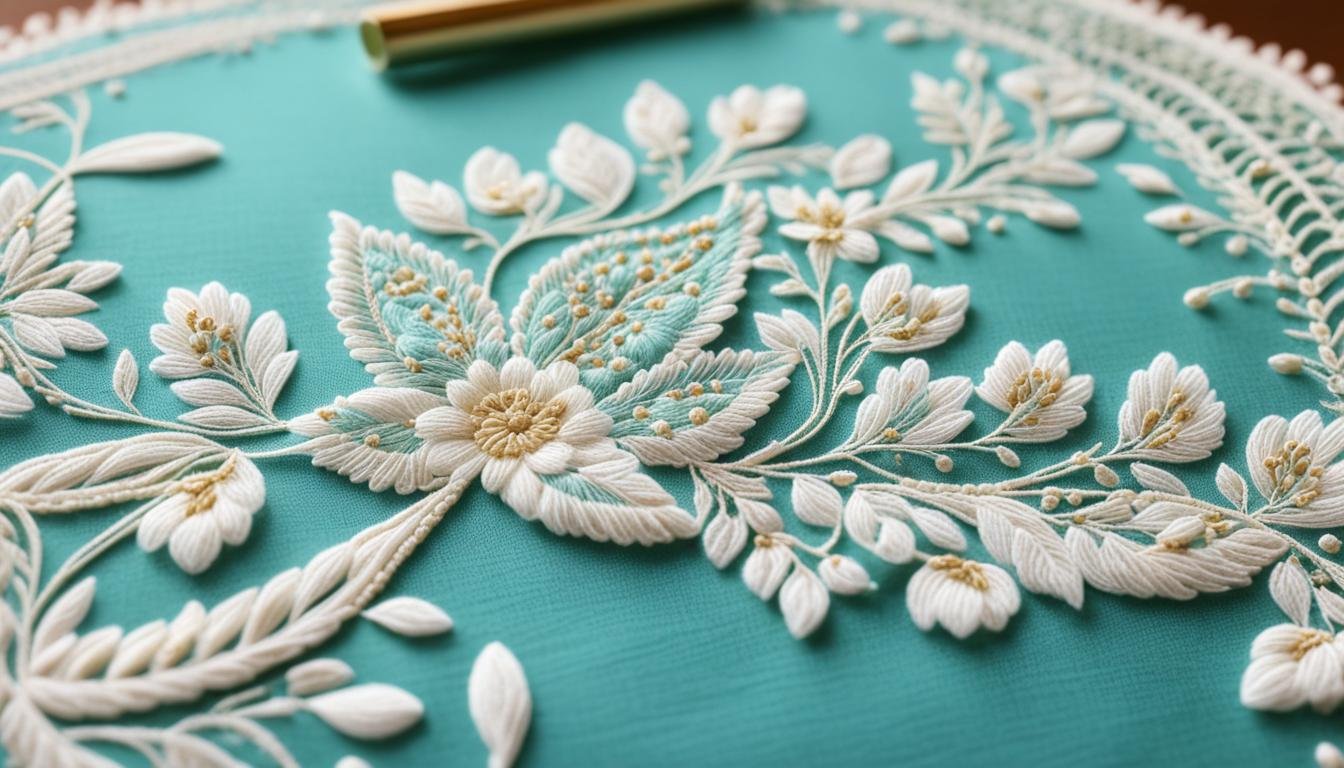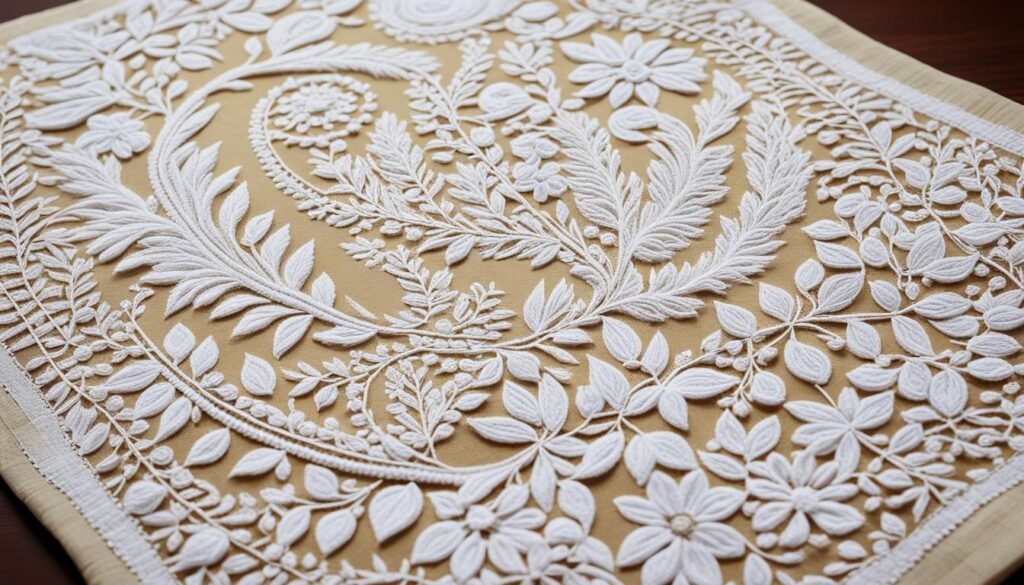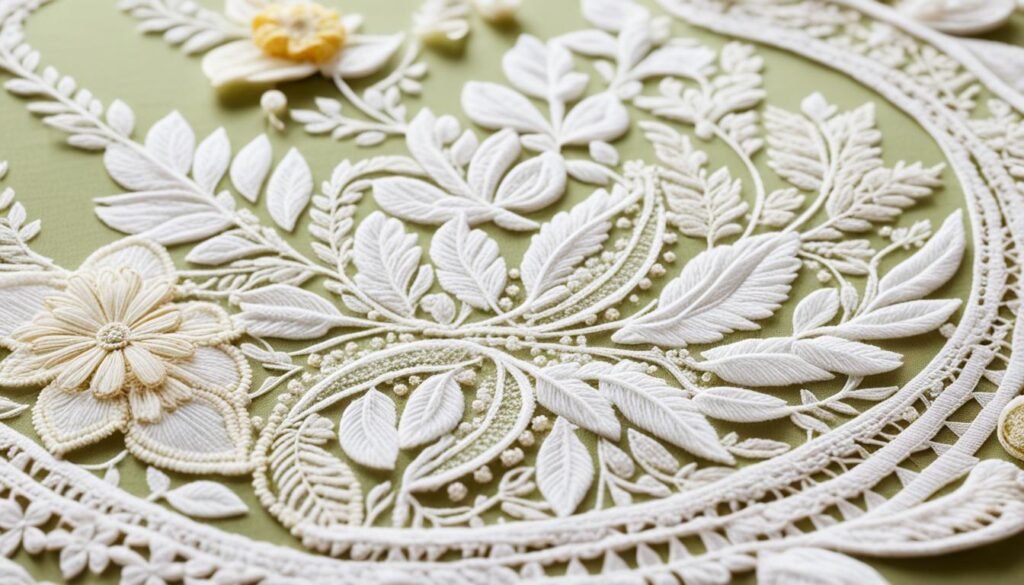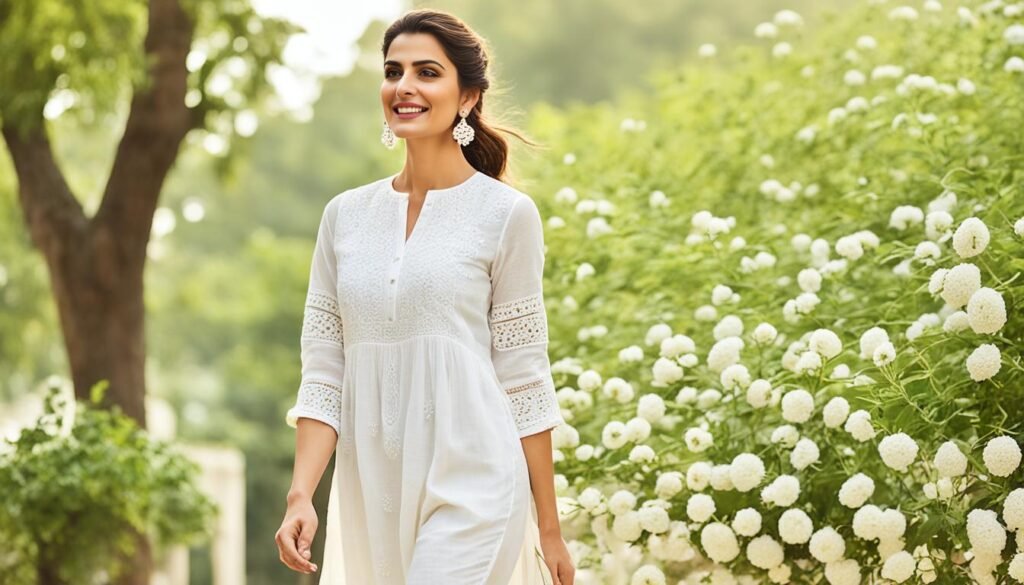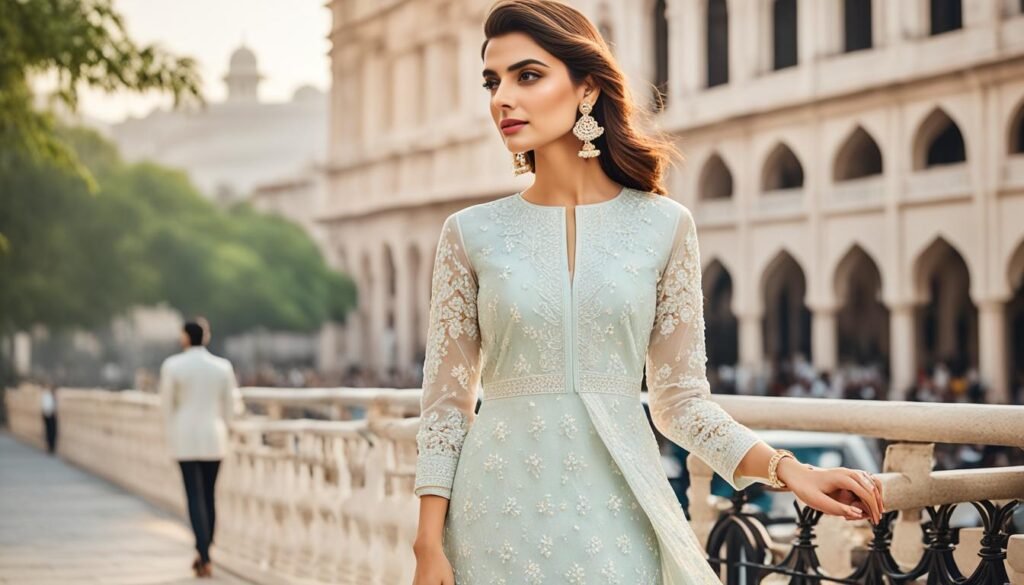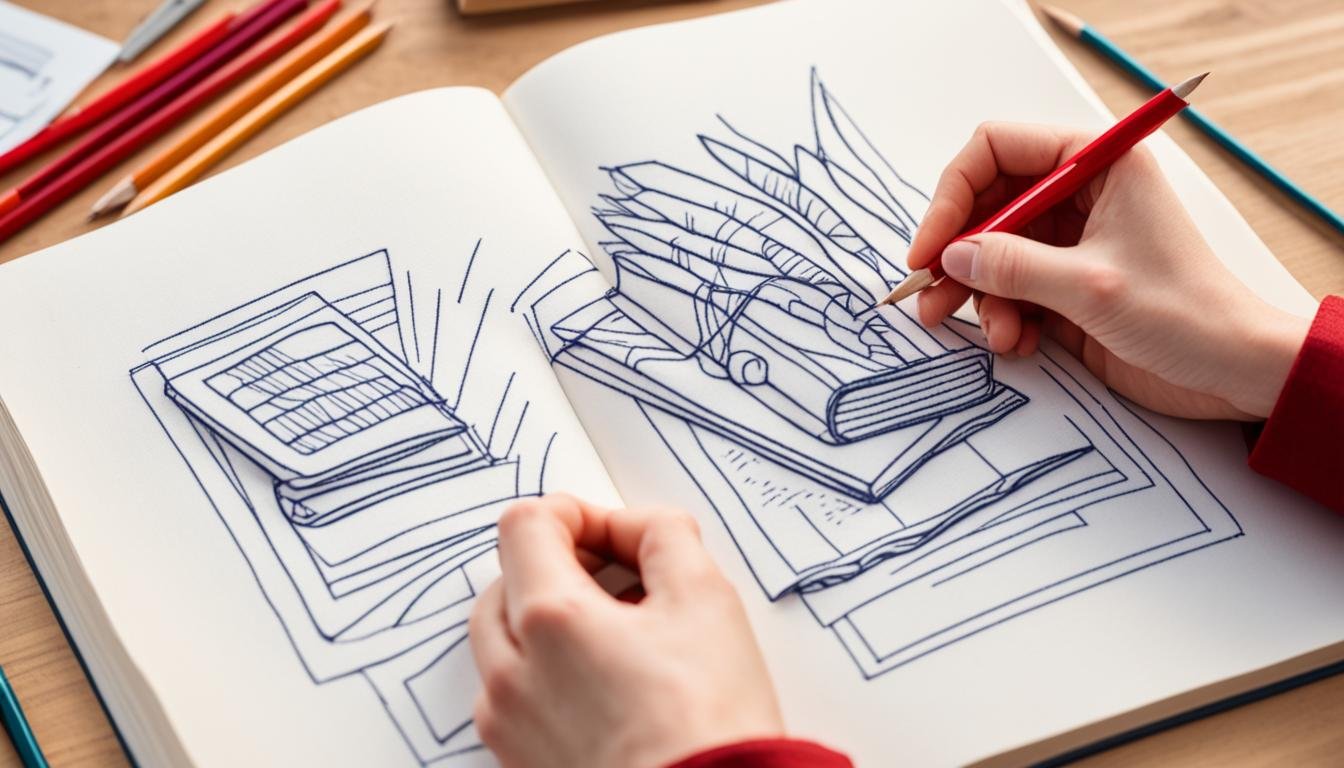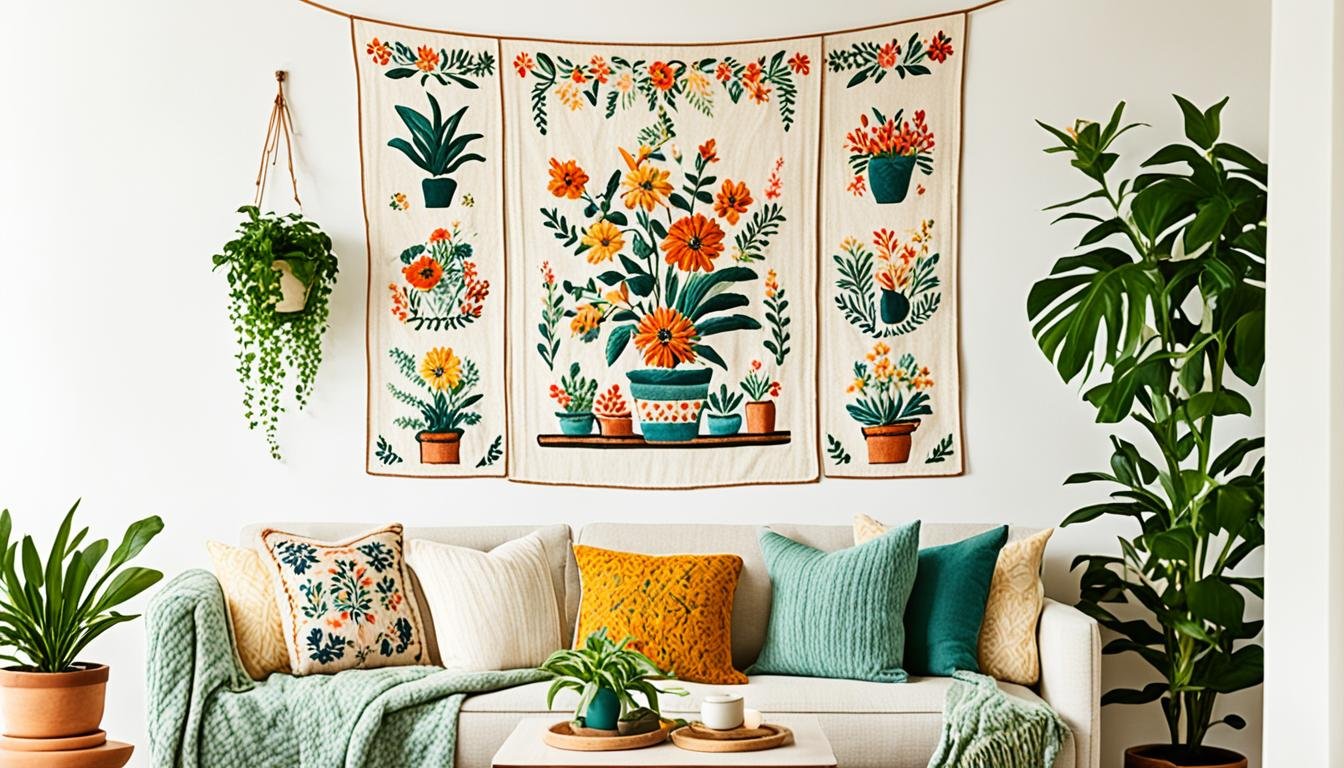I love traditional crafts, and I’m thrilled to share the charm of Chikankari embroidery with you. This Indian hand embroidery shines with timeless beauty. It’s a blend of art and fabric that tells stories of tradition and style.
The ‘House of Chikankari’ is a leading light in this craft. They offer a wide range, from kurtis and kurta sets to anarkalis and kaftans, showing the craft’s versatility.
The detailed embroidery appeals to both classic and modern tastes. They pay close attention to every detail, from the stitch to the lovely Chikankari cloth bags that come with each piece.
‘House of Chikankari’ uses top-notch materials like cotton, mulmul, and silk. This creates items perfect for any event, be it a casual day or a fancy event. The exquisite Chikankari work on these quality fabrics makes each piece fancy.
Table of Contents
ToggleKey Takeaways
- The Chikankari embroidery charm lies in its blend of tradition and modernity.
- ‘House of Chikankari’ offers a wide variety of apparel, providing options for every occasion.
- The use of quality fabrics such as cotton, mulmul, and georgette enhances the elegance in Chikankari.
- Intricate designs and artistic embroidery cater to both traditional and contemporary tastes.
- Meticulous packaging adds to the overall appeal and customer experience.
The Origins of Chikankari Embroidery
Chikankari comes from Lucknow, India. It has a long history and cultural value. This delicate hand-embroidery is a symbol of elegance and high status. It shows the deep artistic roots of the region.
Historical Background
In the 16th century Mughal era, Chikankari started in Lucknow. The Nawabs of Awadh in the 18th and 19th centuries made it popular. It grew with Mughal, Persian, and Turkish influences.
Chikankari uses special stitches on cotton fabrics. Under British rule, it declined but got back up in the 20th century. In 2008, it earned Geographical Indication status for Lucknow.
The Cultural Significance
Lucknow’s Chikankari is deeply meaningful. It honors and celebrates Lucknow’s culture through art. The white threadwork is detailed and timeless. It uses a mix of special stitches.
Chikankari pieces can also have special additions like beads and mirrors. It fits in traditional and modern styles. Buying Chikankari supports local artists and keeps a traditional art alive. It creates jobs for many in Lucknow.
| Aspect | Details |
|---|---|
| Historical Background | Originated during the 16th century Mughal era in Lucknow, evolved under Mughal, Persian, and Turkish influences |
| Geographical Indication (GI) Status | Accorded in December 2008 |
| Stitches | Utilizes Tepchi, Bakhiya, Hool, Murri, Jali, among others |
| Materials | Predominantly done on cotton, Georgette, chiffon, and silk |
| Embellishments | Mukaish, Kamdani, Badla, sequin, bead, and mirror work |
| Cultural Significance | A way to honor and celebrate Lucknow’s cultural traditions, supports local artisans |
The Art of Chikankari Embroidery Techniques
Chikankari embroidery is a craft from India with a long history. It began about 400 years ago in Awadh, under royal support. Noorjahan, the Mughal Emperor Jahangir’s queen, introduced it.
Common Stitches and Patterns
Chikankari uses many stitches to decorate fabric. There are over 40 types, each unique. Some famous ones are Phanda, Baccha, and Bakhia stitches. Modern Chikankari also uses special patterns like muree, lerchi, and bakhia, which show its traditional roots.
The Keel Kangan stitch is great for light fabrics like muslin and chiffon. It makes the design flow smoothly on these delicate materials. Tepchi stitch, on the other hand, makes detailed patterns with running stitches and knots.
Techniques like Shadow Work and Murri add texture to the fabric.
Tools and Materials Used
To make Chikankari, you need the right tools and materials. Fabrics include fine cotton, silk, and more. The most used threads are white cotton, silk, and threads of gold or silver.
Almost all Chikankari is done by women. They use needles and wooden frames for accuracy. The process includes design, block printing, embroidery, and finishing touches, making the garments both tough and beautiful.
What is Special About Chikankari Embroidery
Chikankari embroidery shows beautiful art. Each stitch combines old and new styles. For over 200 years, it has been a symbol of elegance in Lucknow. People all over the world love its unique beauty.
The Unique Elegance of Stitches
Chikankari is known for its detailed stitch work. It uses 32 different stitches like Tepchi and Bakhiya. Each stitch adds its own special touch. For example, the Jali stitch is unique. It makes a perfect look on both sides.
The Murri stitch is often used to make flower centers look lovely. These stitches make Chikankari truly special. More than 5000 families near Lucknow work on this art. They make sure each piece shows their talent.
Modern Interpretations
Today, Chikankari fits well with modern styles. Designers use light fabrics like organza. They also add cotton and silk threads to keep the design classic and trendy.
They also add special touches like Mukaish and sequins. This makes the embroidery shine in new ways. Modern Chikankari honors cultural heritage in a new light.
The Versatility of Chikankari Attire
Chikankari clothes mix tradition with today’s trends. This makes them loved by many. Chikankari suits any event, whether it’s casual or fancy.
Casual Wear
Chikankari casual wear is both comfy and stylish. The fabric is light, perfect for hot days. The Ayah Chikankari Mulmul Straight Kurta in Olive Green is comfy for daily wear. It pairs well with jeans or leggings. Many stars choose Chikankari for its cool, easy vibe.
Formal and Occasion Wear
For dressy events, Chikankari stands out. Its fine details and rich materials are perfect for looking special. Try the Faiza Cotton Straight Kurta for a stunning look. Its design adds beauty and style.
For work, the Inaya Chikankari Modal Straight Kurta is a great pick. It shows off traditional artistry beautifully.
Chikankari is great for every event, from casual to formal. A Chikankari kurta is ideal for daily looks. For special times, its embroidery brings elegance. This handmade style is a classic choice for every closet.
Chikankari in Contemporary Fashion
Chikankari embroidery is now part of today’s fashion world. It has moved beyond its old white-on-white look. Today, it uses many stitching types, colors, and designs.
Collaborations with Designers
Many designers work with Chikankari. They mix it with bold colors like black, red, and blue. You can now find Chikankari on fabrics like chiffon and silk.
Designers also put Chikankari on Western clothes. This makes for stylish outfits that fit many events. Celebrities like Shraddha Kapoor and Sara Ali Khan love wearing Chikankari too.
Artisans use Chikankari for home items like cushions now. This makes the art even more loved.
Although machine-made embroidery is a challenge, many still prefer hand-embroidered Chikankari. This craft helps many, especially women in Lucknow, make a living.
Exploring Chikankari Apparel Varieties
Chikankari is famous for its beautiful details and rich history. We will look at the different styles of Chikankari clothing. They mix old crafting ways with modern fashion trends.
Kurtis and Kurta Sets
Chikankari kurtis and kurta sets are super stylish and comfy. They are usually made from light, airy fabrics like cotton. This makes them great for wearing every day. The Tepchi stitch is key in Chikankari.
But, Bakhiya and Hool stitches also bring out a nice floral look. These outfits look elegant, whether they’re made of silk or muslin. They are perfect all year round, for any event.
Sarees and Lehengas
If you want to stand out with style, choose Chikankari sarees and lehengas. Made from fancy materials like Chanderi and velvet, they truly shine at parties. The Zardosi art and the Murri and Phanda stitches make them look royal. The Keel Kangan stitch is also there, making floral patterns look grand. These dresses highlight Chikankari embroidery’s beauty and flexibility.
| Apparel | Primary Fabrics | Distinctive Features |
|---|---|---|
| Kurtis and Kurta Sets | Cotton, Silk, Muslin | Tepchi, Bakhiya, Hool Stitches |
| Sarees and Lehengas | Chanderi, Velvet | Zardosi, Murri, Phanda Stitches |
The Elegance of Chikankari Fabrics
The beauty of Chikankari embroidery shines on different fabrics. You can pick from soft cotton to fancy georgette. Each fabric is special and shows off Chikankari’s details well. We will talk about cotton and mulmul fabrics first, then georgette and silk ones.
Cotton and Mulmul
Cotton is great for Chikankari because it breathes well and is comfy. It’s strong and lasts a long time, perfect for daily wear and summer. Mulmul is another fine cotton choice, famous for its light feel. T
hese fabrics go back to the Mughal Empire in the 16th century, used in Lucknow. Cotton and mulmul work well with over 30 stitch types in Chikankari. This offers a lot of pattern options.
Georgette and Silk
Georgette and silk Chikankari fabrics are all about luxury. Georgette is light and sheer, great for fancy wear and embroidery. Silk, like Chanderi silk, makes Chikankari shine bright for parties and special days.
In the past, Chikankari used white yarn on plain muslin. But now, georgette and silk open new doors with colorful designs.
Lots of artisans work together to make each Chikankari piece special. The comfy cotton and mulmul, or the more fancy georgette and silk – they all win hearts with their beauty and detail.
Preserving the Craft: Artisans and Their Stories
Preserving Chikankari craft shows how dedicated and strong the artisans in Lucknow are. They are why Chikankari is still loved all over. This craft’s tradition goes back over 300 years. There are more than 40 stitches in Chikankari, with about 30 used today.
Skilled Artisans of Lucknow
Lucknow is famous for Chikankari’s beauty and detail. In the past, embroiderers stretched fabric with their left hand for accuracy. Different artisans do specific jobs in Chikankari like filling work and outlining to ensure top-notch quality.
The designs come from Lucknow’s architecture, showing things like mosaics, flowers, and paisleys. Usually, women do the embroidery, keeping a tradition that highlights their importance in Chikankari.
The Role of Online Boutiques
Online Chikankari boutiques play a key role in keeping the craft alive. They make Lucknow artisans’ beautiful work available worldwide. Places like Marasim, started by Nidhi Garg Allen, work with different artisans to sell their items.
This helps to share the stories of artisans and gives them more notice and money. When we buy from these online boutiques, we help artisans and keep this craft going for the next generations.
The Importance of Quality and Packaging
Chikankari is more than just beautiful embroidery. It’s about caring for every single part of the process, from the materials chosen to how it’s finally wrapped up.
This care means that every Chikankari item is top-notch. To truly understand and love this art, you need to see the effort put into making each piece perfect.
Attention to Detail
Chikankari Kurtis often use top-quality fabrics like Georgette and Chanderi. They feel amazing and look stunning. The detail doesn’t stop there. The threads used, like white cotton on muslin or silk, are picked with great thought.
Around 30 different stitches are used to make sure every piece is beautiful. This extra effort shows in how superb the Chikankari items are.
Customer Experience
Shopping for Chikankari is more than buying clothes. It’s a whole experience from start to finish. Stores like Madhav Fashion go all out to make customers happy. They offer help that’s just for you.
Plus, their Chikankari wrapping is as elegant as the item inside, and they use eco-friendly stuff, which is great for the planet. Each piece comes with a realness certificate, so you know it’s not just great, it’s real.
Conclusion
Chikankari embroidery comes from Lucknow, India, since the 17th century. It shows amazing skill and a long history. This craft isn’t just about looking good. It’s a sign of deep traditions and culture.
Chikankari embroidery fits well in today’s styles, loved by top designers and brands. It includes styles like Phulkari and Zardosi. They all bring out bright colors and fine designs. This makes shopping for Chikankari fun, with many choices for daily and special wear expresses this perfectly.
Loving Chikankari is more than liking how it looks. It’s also supporting good fashion and the people who make it. Designers who use Chikankari help keep old, special ways alive, like shadow and Jaali work.
This keeps the beauty of Chikankari alive for the coming times. Enjoy the beauty of Chikankari fabrics and the hard work of its crafters. Let it encourage you to value and help spread this pretty craft through loving and support.
FAQ
What is Chikankari embroidery and where does it originate from?
Chikankari is a type of hand embroidery. It started in Lucknow, India. It’s rich in history and culture from the area.
What fabrics are commonly used for Chikankari embroidery?
Chikankari uses soft and fancy fabrics. This includes cotton, mulmul, georgette, and silk. These fabrics make the embroidery look elegant.
What makes Chikankari embroidery unique?
Chikankari is special for its fine work and different stitches. It combines tradition with new trends. This keeps it popular over time.
How is Chikankari embroidery relevant in modern fashion?
Today, many designers use Chikankari in their work. It mixes old crafting with new styles. This makes it popular in both fancy and daily clothes.
Can you explain the versatility of Chikankari attire?
Chikankari clothes can be worn every day or for special events. It is done on cotton for daily wear and on silk for celebrations. This shows its flexibility.
Who are the artisans behind Chikankari embroidery?
The skilled workers in Lucknow do Chikankari. They use traditional tools to keep the work precise and beautiful. They are vital to Chikankari.
How do online boutiques contribute to the preservation of Chikankari craft?
Online shops help spread Chikankari worldwide. They tell the stories of the workers. And they give a place for their work to be seen globally.
What types of garments feature Chikankari embroidery?
Chikankari can be on many clothes. This includes kurtis, sarees, and lehengas. They show off the deep tradition and style of Chikankari.
What is the importance of quality and packaging in Chikankari products?
Chikankari’s value goes beyond the outfit. Good packaging and attention to detail are key. They give a top-notch feel to the whole experience.
What role do historical and cultural aspects play in Chikankari embroidery?
Chikankari is linked to a long history and culture. It was a sign of elegance and class in the past. These aspects still make Chikankari special today.
